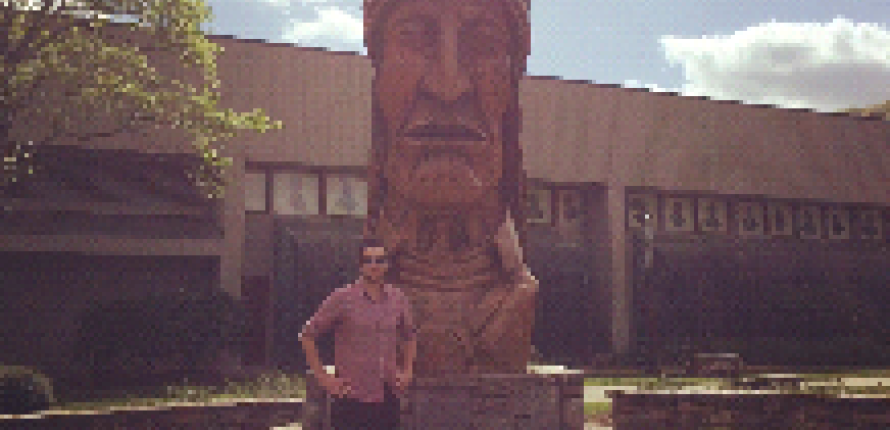Discovering Native America on my Fulbright Experience

Christian O’Connell, Senior Lecturer of American History, University of Gloucestershire, UK
2015-2016 Fulbright Visiting Scholar to Elon University
This is the second part of a blog post written by Fulbright Visiting Scholar Christian O'Connell. Click to read the Part I of the post.
Being in a vibrant environment such as Elon, there were always plenty of options for extracurricular activities, from the university sports teams to theatrical performances and guest talks. A highlight of my time at Elon was the guest lecture given by Dennis and Ralph Zotigh from the Kiowa Nation of Oklahoma. Dennis Zotigh (Kiowa, Santee Dakota and Ohkay Owingeh Pueblo) is a Cultural Specialist with the Smithsonian National Museum of the American Indian in Washington, D.C. and a widely respected lecturer and performer. His father, Ralph Zotigh (Kiowa) is an esteemed elder in the Kiowa community, lead singer for the award-winning Zotigh Singers powwow drum, and a former faculty member at the Institute of American Indian Arts in Santa Fe, New Mexico. They visited the class of Elon’s Native American specialist Professor Clyde Ellis and discussed the role of song and music in the preservation of various Native cultures across North America. This included the performance of many traditional songs that spoke of ceremonies, stories and origins myths of different Native tribes across North America. Hearing these songs in persons was incredible to say the least, and highlighted how song is still used as a means of passing on tribal heritage.
Dennis Zotigh also gave insights into his role at the Smithsonian and discussed the challenges of often being asked to speak on behalf of all Native peoples in the United States, which means frequently challenging many of the simplistic assumptions held by visitors to the museum about Native Americans. One of the projects he has been working on is ‘Meet Native America,’ an interview series with tribal leaders and other significant Native peoples exploring contemporary Native life and culture. Attending this class reminded me of the importance of making use of history in the real world in the classroom. Knowing that some of the subjects studied in class have a function in the wider world can be brought through field trips and guest speakers, and this is something I intend to do more often back in the UK.

Being in North Carolina I was also able to visit the town of Cherokee, home to the Eastern Band Cherokees, located east of the Great Smoky Mountains National Park. The settlement was founded by around 800 Cherokees who refused to bow to the federal government’s enforcement of the Indian Removal Act of 1830. This event, more commonly known as the ‘Trail of Tears,’ saw around 15,000 Cherokees forcibly relocated to the Oklahoma territory, a perilous journey through a harsh winter in which 4,000 lost their lives. Oklahoma has since been the home of the two other Cherokee Reservations, the United Keetowah Band of Cherokee Indians and the Cherokee Nation. Cherokee in North Carolina is located along the Qualla Boundary, a territory originally occupied by the Cherokees before removal, and purchased by tribal members from the federal government. While there, I visited the Museum of the Cherokee Indian, which provided a sensitive and informative account of the Native and Cherokee past from pre-history to the 20th century. The museum did an excellent job of combining the tribe’s material culture and oral traditions within the rapidly changing context of colonial and early American history. The museum also charts how the tribe actively resisted American encroachment and attempted to hold the Federal government to its numerous treaty obligations throughout the 18th and 19th centuries. Also included was ‘Emissaries of Peace: 1762 Cherokee & British Delegations,’ a rich and illustrative exhibition based on Henry Timberlake’s Memoirs (1765). This display charts Timberlake’s experiences with the Cherokees, as well as their journeys to London to meet King George III. The materials from this exhibit are a testament to the long periods of co-existence between Europeans and Native peoples, before the traumatic events that followed the American Revolution in the 19th century. The Cherokees traded with the British for over 50 years in the 18th century, but the Museum is sensitive to the nuances of these relationships, highlighting how trade and new items (such as weapons and everyday items such as scissors) had a dramatic impact on traditional life and practices of the Cherokees. It is a shame I cannot take my British students to this museum, as it is a very good example of how public history can be done while paying attention to the complexity and rich nature of American history.

While at the Reservation, I also was able to see how tourism has become essential to the local economy, especially in the case of the Harrah Casino. Much of the profits from this are invested into local infrastructure, education, housing, and policing. However, the contrasts between the more authentic Qualla Arts Centre (which includes hand-made artefacts from tribal members) and the more artificial and derivative tourist gift shops on the opposite side of the road, are evidence of the tension between accommodating and meeting the demands of tourism – a necessary source of income for the Reservation - and the preservation of traditional Cherokee culture. Nonetheless, given the standard of the Museum, as well as the illuminating talk by Dennis and Ralph Zotigh, I have become much more aware about how Native Americans are actively preserving their diverse cultures and histories, in many cases beyond tunnel vision of (sometimes naïve) tourists. It also acted as a reminder of how fundamental these histories are to understanding American history.
This experience really captured my imagination, and got me thinking about my own teaching of Native American history, which is predominantly focused on the South-eastern tribes and their struggles against removal in the 1830s. As a British scholar of American History, I believe that Native American history does not get the attention it deserves in the UK, and all too often the narrative is dominated by stories of loss, encroachment and reservations. However, there are also stories of resistance, survival and joy. The Native American past is as fundamental to understanding the history of America as the actions of the Founding Fathers, the history of slavery, or the Civil Rights Movement. Importantly, during my time in North Carolina, I have also been reminded that there is much to learn about Native peoples in the 21st century.Their experiences today can tell us a lot about the contemporary state of American democracy, freedom, and the American dream. Learning so much about Native America was a welcome surprise for me, particularly as this is not my main research area. For future Fulbrighters, my advice would be to not confine yourselves to the boundaries of your teaching or research. Embrace all the possibilities that will inevitably present themselves by simply being in America.
